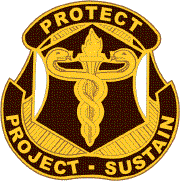Fort Detrick
Appearance


Fort Detrick is a grouping of facilities on U.S. federally-owned land constituting a military base in Frederick. Maryland. The military base is under the aegis of the United States Army Futures Command. Fort Detrick has a mission mandate to pursue biomedical research and development, defense against biowarfare and bioterrorism, and specialty containment for dangerous biological agents. Its predecessor military organizations were Detrick Field (1931 to 1943) and Camp Detrick (from 1943 to 1956).
Quotes
[edit]- Blome's admirers at Camp Detrick could not protect him from indictment. Instead they concentrated on securing his acquittal. Blome put up a spirited defense.
- Stephen Kinzer, Poisoner in Chief: Sidney Gottlieb and the CIA Search for Mind Control. Henry Holt and Company. 10 September 2019. ISBN 9781250140449.
- There were some episodes of infection, but they weren't all that bad. In any case, anything that did happen on the post was restricted to the post. Nobody got infected at Camp Detrick and started an epidemic outside in Frederick, Maryland. It was contained on the post. I mention this because all of the horrifying scenarios that have been written by molecular biologists and science fiction writers don't have to happen. Many of these proved methods and techniques of handling organisms and storing them, having access to them, were developed in Camp Detrick. These are still the criteria by which most people in pathogenic microbiology operate.
- Edwin H. Lennette, "Pioneer of Diagnostic Virology with the California Department of Public Health, an oral history conducted in 1982, 1983, and 1986 by Sally Hughes, Regional Oral History Office, The Bancroft Library, University of California, Berkeley, 1988, p. 84
- Painstakingly, the germ-development program at Fort Detrick had tested prospective germ weapons on nearly a thousand American soldiers, in sealed chambers and the wilds of the Utah desert. Reaching beyond the military, it had exposed prisoners at the Ohio State Penitentiary, where volunteers were carefully monitored. Clandestinely, it also sprayed American cities with mild germs to investigate the likely impact of deadly pathogens.
- Judith Miller, William J. Broad, and Stephen Engelbert, Germs: Biological Weapons and America's Secret War. Simon and Schuster. February 2012. ISBN 9781439128152. (quote from p. 35)
- Around the corner from Jahrling's office is a room known as the Secure Room, which is always kept locked. Inside it there is a stew phone, a secure fax machine, and several safes with combination locks. Inside the safes are sheets of paper in folders. The sheets contain formulas for biological weapons. Some of the weapons may be Soviet, some possibly may be Iraqi, and a number of the formulas are American and were developed at Fort Detrick in the nineteen sixties, before offensive bioweapons research in the United States was banned.
- Richard Preston, The Demon in the Freezer: A True Story. Random House Publishing. 26 August 2003. ISBN 9780345466631. (quote from p. 24)
- In 1940, with Europe into its second great war, the federal government leased the field for use in its Cadet Pilot Training Program. The Army erected the barracks and the large hangar, and poured concrete for an aircraft tie-down ramp, a taxiway, and sidewalks. That was the physical state of the place when on March 9, 1943, the Army Chemical Warfare Service took formal possession of Detrick Field, annexed some of the surrounding farmland for field trials, and renamed it Camp Detrick.
Personnel started arriving in April. They were not pilots or even, for the most part, military men. They were civilian biologists whose task was to mass-produce germ weapons. Their first order of business was to fill the British production order for "three kilo dried X."- Ed Regis, The Biology of Doom: America's Secret Germ Warfare Project. Macmillan. October 2000. ISBN 9780805057652. (quote from p. 41)
- In 1943, the United States began research into the use of biological agents for offensive purposes. This work was started, interestingly enough, in response to a perceived German biological biological warfare (BW) threat as opposed to a Japanese one. The United States conducted this research at Camp Detrick (now Fort Detrick), which was a small National Guard airfield prior to that time, and produced agents at other sites until 1969, when President Nixon stopped all offensive biological and toxin weapon research and production by executive order.
- U.S. Army Medical Research Institute of Infectious Diseases, Medical Management of Biological Casualties Handbook. Government Printing Office. 2001. ISBN 9780160876196. (quote from p. 4)
External links
[edit]![]() Encyclopedic article on Fort Detrick on Wikipedia
Encyclopedic article on Fort Detrick on Wikipedia
